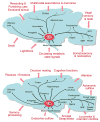The lateral hypothalamus as integrator of metabolic and environmental needs: from electrical self-stimulation to opto-genetics
- PMID: 21549732
- PMCID: PMC3131619
- DOI: 10.1016/j.physbeh.2011.04.051
The lateral hypothalamus as integrator of metabolic and environmental needs: from electrical self-stimulation to opto-genetics
Abstract
As one of the evolutionary oldest parts of the brain, the diencephalon evolved to harmonize changing environmental conditions with the internal state for survival of the individual and the species. The pioneering work of physiologists and psychologists around the middle of the last century clearly demonstrated that the hypothalamus is crucial for the display of motivated behaviors, culminating in the discovery of electrical self-stimulation behavior and providing the first neurological hint accounting for the concepts of reinforcement and reward. Here we review recent progress in understanding the role of the lateral hypothalamic area in the control of ingestive behavior and the regulation of energy balance. With its vast array of interoceptive and exteroceptive afferent inputs and its equally rich efferent connectivity, the lateral hypothalamic area is in an ideal position to integrate large amounts of information and orchestrate adaptive responses. Most important for energy homeostasis, it receives metabolic state information through both neural and humoral routes and can affect energy assimilation and energy expenditure through direct access to behavioral, autonomic, and endocrine effector pathways. The complex interplays of classical and peptide neurotransmitters such as orexin carrying out these integrative functions are just beginning to be understood. Exciting new techniques allowing selective stimulation or inhibition of specific neuronal phenotypes will greatly facilitate the functional mapping of both input and output pathways.
Copyright © 2011 Elsevier Inc. All rights reserved.
Figures





References
-
- Bruegger M. Fresstrieb als hypothalamisches Syndrom. Helvetica Physiologica Acta. 1943;1:183–198.
-
- Hess W. Das Zwischenhirn: Syndrome, Localisationen, Funktionen. Basel: Schwabe; 1949.
-
- Anand BK, Brobeck JR. Localization of a “feeding center” in the hypothalamus of the rat. Proc Soc Exp Biol Med. 1951;77(2):323–4. - PubMed
-
- Brobeck JR. Mechanism of the development of obesity in animals with hypothalamic lesions. Physiol Rev. 1946;26(4):541–59. - PubMed
-
- Olds J, Milner P. Positive reinforcement produced by electrical stimulation of septal area and other regions of rat brain. J Comp Physiol Psychol. 1954;47(6):419–27. - PubMed
Publication types
MeSH terms
Grants and funding
LinkOut - more resources
Full Text Sources
Research Materials

